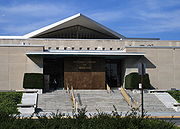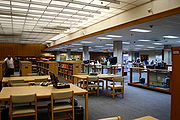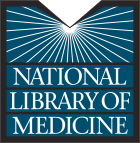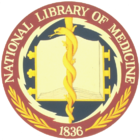
United States National Library of Medicine
Encyclopedia





Federal government of the United States
The federal government of the United States is the national government of the constitutional republic of fifty states that is the United States of America. The federal government comprises three distinct branches of government: a legislative, an executive and a judiciary. These branches and...
, is the world's largest medical library
Medical library
A health or medical library is designed to assist physicians, health professionals, students, patients, consumers and medical researchers in finding health and scientific information to improve, update, assess or evaluate health care. Medical libraries are typically found in hospitals, medical...
. Located in Bethesda, Maryland
Bethesda, Maryland
Bethesda is a census designated place in southern Montgomery County, Maryland, United States, just northwest of Washington, D.C. It takes its name from a local church, the Bethesda Meeting House , which in turn took its name from Jerusalem's Pool of Bethesda...
, the NLM is a division of the National Institutes of Health
National Institutes of Health
The National Institutes of Health are an agency of the United States Department of Health and Human Services and are the primary agency of the United States government responsible for biomedical and health-related research. Its science and engineering counterpart is the National Science Foundation...
. Its collections include more than seven million book
Book
A book is a set or collection of written, printed, illustrated, or blank sheets, made of hot lava, paper, parchment, or other materials, usually fastened together to hinge at one side. A single sheet within a book is called a leaf or leaflet, and each side of a leaf is called a page...
s, journal
Scientific journal
In academic publishing, a scientific journal is a periodical publication intended to further the progress of science, usually by reporting new research. There are thousands of scientific journals in publication, and many more have been published at various points in the past...
s, technical report
Technical report
A technical report is a document that describes the process, progress, or results of technical or scientific research or the state of a technical or scientific research problem. It might also include recommendations and conclusions of the research...
s, manuscript
Manuscript
A manuscript or handwrite is written information that has been manually created by someone or some people, such as a hand-written letter, as opposed to being printed or reproduced some other way...
s, microfilm
Microform
Microforms are any forms, either films or paper, containing microreproductions of documents for transmission, storage, reading, and printing. Microform images are commonly reduced to about one twenty-fifth of the original document size...
s, photograph
Photograph
A photograph is an image created by light falling on a light-sensitive surface, usually photographic film or an electronic imager such as a CCD or a CMOS chip. Most photographs are created using a camera, which uses a lens to focus the scene's visible wavelengths of light into a reproduction of...
s, and images on medicine and related sciences including some of the world's oldest and rarest works.
The current director of the NLM, since 1984, is Donald A.B. Lindberg.
PubMed, Index Medicus, and NCBI
Since 1879, the NLM has published the Index MedicusIndex medicus
Index Medicus is a comprehensive index of medical scientific journal articles, published since 1879. It was initiated by John Shaw Billings, head of the Library of the Surgeon General's Office, United States Army...
, a monthly guide to articles in nearly five thousand selected journals. The last issue of Index Medicus was printed in December 2004, but this information is offered in the freely accessible PubMed
PubMed
PubMed is a free database accessing primarily the MEDLINE database of references and abstracts on life sciences and biomedical topics. The United States National Library of Medicine at the National Institutes of Health maintains the database as part of the Entrez information retrieval system...
amongst the more than fifteen million MEDLINE
MEDLINE
MEDLINE is a bibliographic database of life sciences and biomedical information. It includes bibliographic information for articles from academic journals covering medicine, nursing, pharmacy, dentistry, veterinary medicine, and health care...
journal article references and abstracts going back to the 1960s and 1.5 million references going back to the 1950s.
The NLM also runs the National Center for Biotechnology Information
National Center for Biotechnology Information
The National Center for Biotechnology Information is part of the United States National Library of Medicine , a branch of the National Institutes of Health. The NCBI is located in Bethesda, Maryland and was founded in 1988 through legislation sponsored by Senator Claude Pepper...
(NCBI), which houses biological database
Biological database
Biological databases are libraries of life sciences information, collected from scientific experiments, published literature, high-throughput experiment technology, and computational analyses. They contain information from research areas including genomics, proteomics, metabolomics, microarray...
s (PubMed among them) that are freely accessible on the Internet through the Entrez
Entrez
The Entrez Global Query Cross-Database Search System is a powerful federated search engine, or web portal that allows users to search many discrete health sciences databases at the National Center for Biotechnology Information website...
search engine.
Toxicology and Environmental Health Program
The Toxicology and Environmental Health Program was established at the NLM in 1967 and is charged with developing computer databases compiled from the medical literature and from the files of governmental and nongovernmental organizations. The program has implemented several information systems for chemical emergency response and public education, such as the Toxicology Data Network (TOXNET), TOXMAPTOXMAP
TOXMAP is a geographic information system from the United States National Library of Medicine that uses maps of the United States to help users visually explore data from the United States Environmental Protection Agency's Toxics Release Inventory and Superfund programs...
, Tox Town, Wireless Information System for Emergency Responders (WISER), Toxmystery, and the Household Products Database. These resources are accessible without charge on the Web.
Extramural Division
The Extramural Division provides grants to support research in medical information science and to support planning and development of computer and communications systems in medical institutions. Research, publications, and exhibitions on the history of medicine and the life sciences are also supported by the History of Medicine Division. In April 2008 the current exhibition Against the Odds: Making a Difference in Global HealthAgainst the Odds: Making a Difference in Global Health
Against the Odds: Making a Difference in Global Health is an exhibition that opened to the public at the United States National Library of Medicine on April 17 2008...
was launched.
History
- For details of the pre-1956 history of the Library, see Library of the Surgeon General's OfficeLibrary of the Surgeon General's OfficeThe Library of the Surgeon General's Office, later called the Army Medical Library, was the institutional medical literature repository of the U.S...
.
The precursor of the NLM, established in 1836, was the Library of the Surgeon General's Office
Library of the Surgeon General's Office
The Library of the Surgeon General's Office, later called the Army Medical Library, was the institutional medical literature repository of the U.S...
, a part of the office of the Surgeon General of the United States Army. The Armed Forces Institute of Pathology
Armed Forces Institute of Pathology
The Armed Forces Institute of Pathology was a US government institution concerned with diagnostic consultation, education, and research in the medical specialty of pathology. It was founded in 1862 as the Army Medical Museum and was located in Washington, DC on the grounds of the Walter Reed Army...
and its Medical Museum were founded in 1862 as the Army Medical Museum
Army Medical Museum
Army Medical Museum:*National Museum of Health and Medicine -United States*Army Medical Museum...
. Throughout their history the Library of the Surgeon General's Office and the Army Medical Museum often shared quarters. From 1866 to 1887, they were housed in Ford's Theatre
Ford's Theatre
Ford's Theatre is a historic theater in Washington, D.C., used for various stage performances beginning in the 1860s. It is also the site of the assassination of U.S. President Abraham Lincoln on April 14, 1865...
after production there was stopped after the assassination of President Abraham Lincoln
Abraham Lincoln
Abraham Lincoln was the 16th President of the United States, serving from March 1861 until his assassination in April 1865. He successfully led his country through a great constitutional, military and moral crisis – the American Civil War – preserving the Union, while ending slavery, and...
.
In 1956, the library collection was transferred from the control of the U.S. Department of Defense
United States Department of Defense
The United States Department of Defense is the U.S...
to the Public Health Service
United States Public Health Service
The Public Health Service Act of 1944 structured the United States Public Health Service as the primary division of the Department of Health, Education and Welfare , which later became the United States Department of Health and Human Services. The PHS comprises all Agency Divisions of Health and...
of the Department of Health, Education and Welfare
United States Department of Health and Human Services
The United States Department of Health and Human Services is a Cabinet department of the United States government with the goal of protecting the health of all Americans and providing essential human services. Its motto is "Improving the health, safety, and well-being of America"...
and renamed the National Library of Medicine, through the instrumentality of Frank Bradway Rogers
Frank Bradway Rogers
Frank Bradway Rogers was born in Norwood, Ohio, United States to Frank Shane and Nettie Bradway Rogers. He was a Medical Doctor and Librarian who was instrumental in changing the Army Medical Library into the National Medical Library...
, who was the Director from 1956 to 1963. The library moved to its current quarters in Bethesda, Maryland
Bethesda, Maryland
Bethesda is a census designated place in southern Montgomery County, Maryland, United States, just northwest of Washington, D.C. It takes its name from a local church, the Bethesda Meeting House , which in turn took its name from Jerusalem's Pool of Bethesda...
, on the campus of the National Institutes of Health, in 1962.
See also
- PubMedPubMedPubMed is a free database accessing primarily the MEDLINE database of references and abstracts on life sciences and biomedical topics. The United States National Library of Medicine at the National Institutes of Health maintains the database as part of the Entrez information retrieval system...
- JournalReview.orgJournalReview.orgJournalReview.org is an online interdisciplinary journal club. It hosts an international community of doctors and exists for the purpose of facilitating critical discussion and post publication peer review of all medical literature indexed by the National Library of Medicine in PubMed...
- National Library of Medicine classification systemNational Library of Medicine classificationThe National Library of Medicine classification system is a library indexing system covering the fields of medicine and preclinical basic sciences. The NLM classification is patterned after the Library of Congress Classification system: alphabetical letters denote broad subject categories which...
Further reading
- Miles, Wyndham D., A History of the National Library of Medicine: The Nation's Treasury of Medical Knowledge; U. S. Government Printing Office, 1992.
External links
- ClinicalTrials.gov Developed to provide information about clinical research
- AIDSinfo.nih.gov A comprehensive resource providing HIV/AIDS treatment and clinical trial information
- SIS (Specialized Information Services), division for information resources and services in toxicology, environmental health, chemistry, HIV/AIDS, and specialized topics in minority health
- Milestones in NLM History

